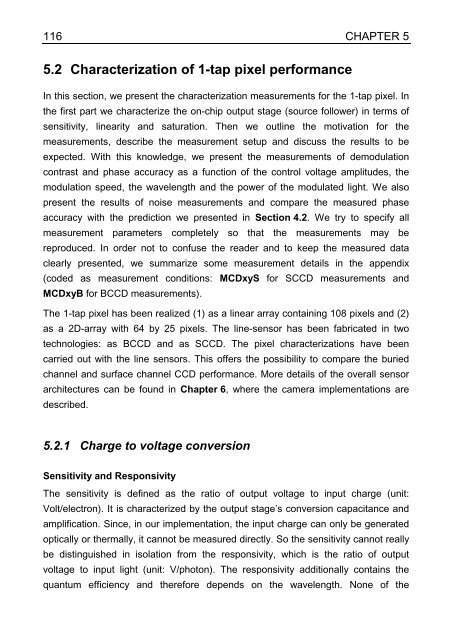3D Time-of-flight distance measurement with custom - Universität ...
3D Time-of-flight distance measurement with custom - Universität ...
3D Time-of-flight distance measurement with custom - Universität ...
Create successful ePaper yourself
Turn your PDF publications into a flip-book with our unique Google optimized e-Paper software.
116 CHAPTER 5<br />
5.2 Characterization <strong>of</strong> 1-tap pixel performance<br />
In this section, we present the characterization <strong>measurement</strong>s for the 1-tap pixel. In<br />
the first part we characterize the on-chip output stage (source follower) in terms <strong>of</strong><br />
sensitivity, linearity and saturation. Then we outline the motivation for the<br />
<strong>measurement</strong>s, describe the <strong>measurement</strong> setup and discuss the results to be<br />
expected. With this knowledge, we present the <strong>measurement</strong>s <strong>of</strong> demodulation<br />
contrast and phase accuracy as a function <strong>of</strong> the control voltage amplitudes, the<br />
modulation speed, the wavelength and the power <strong>of</strong> the modulated light. We also<br />
present the results <strong>of</strong> noise <strong>measurement</strong>s and compare the measured phase<br />
accuracy <strong>with</strong> the prediction we presented in Section 4.2. We try to specify all<br />
<strong>measurement</strong> parameters completely so that the <strong>measurement</strong>s may be<br />
reproduced. In order not to confuse the reader and to keep the measured data<br />
clearly presented, we summarize some <strong>measurement</strong> details in the appendix<br />
(coded as <strong>measurement</strong> conditions: MCDxyS for SCCD <strong>measurement</strong>s and<br />
MCDxyB for BCCD <strong>measurement</strong>s).<br />
The 1-tap pixel has been realized (1) as a linear array containing 108 pixels and (2)<br />
as a 2D-array <strong>with</strong> 64 by 25 pixels. The line-sensor has been fabricated in two<br />
technologies: as BCCD and as SCCD. The pixel characterizations have been<br />
carried out <strong>with</strong> the line sensors. This <strong>of</strong>fers the possibility to compare the buried<br />
channel and surface channel CCD performance. More details <strong>of</strong> the overall sensor<br />
architectures can be found in Chapter 6, where the camera implementations are<br />
described.<br />
5.2.1 Charge to voltage conversion<br />
Sensitivity and Responsivity<br />
The sensitivity is defined as the ratio <strong>of</strong> output voltage to input charge (unit:<br />
Volt/electron). It is characterized by the output stage’s conversion capacitance and<br />
amplification. Since, in our implementation, the input charge can only be generated<br />
optically or thermally, it cannot be measured directly. So the sensitivity cannot really<br />
be distinguished in isolation from the responsivity, which is the ratio <strong>of</strong> output<br />
voltage to input light (unit: V/photon). The responsivity additionally contains the<br />
quantum efficiency and therefore depends on the wavelength. None <strong>of</strong> the

















